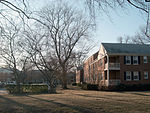Dyke Marsh

Dyke Marsh is a freshwater wetland and wildlife preserve located on the west bank of the Potomac River south of Alexandria, Virginia between Old Town Alexandria and Mount Vernon. Dyke Marsh consists of about 380 acres (1.5 km2) of tidal marsh, floodplain, and swamp forest. It formed 5,000 to 7,000 years ago. With a total size of 485 acres, Dyke Marsh is one of the largest remaining pieces of freshwater tidal wetlands left in the Baltimore-Washington Metropolitan Area. The marsh is managed by the National Park Service as part of the George Washington Memorial Parkway. Dyke Marsh contains a wide array of plant and animal life. "Haul Road" is a trail that leads visitors into the marsh. It is frequented by area birdwatchers. Dyke Marsh is located off the George Washington Memorial Parkway at the Belle Haven Marina exit. Here the fresh water of the upper Potomac mixes with the salt water of the lower Potomac. The fresh water tends to float above the tidal salt water producing a tidal freshwater marsh.
Excerpt from the Wikipedia article Dyke Marsh (License: CC BY-SA 3.0, Authors, Images).Dyke Marsh
Mount Vernon Trail,
Geographical coordinates (GPS) Address Website Nearby Places Show on map
Geographical coordinates (GPS)
| Latitude | Longitude |
|---|---|
| N 38.767777777778 ° | E -77.048611111111 ° |
Address
Dyke Marsh Wildlife Preserve
Mount Vernon Trail
22307
Virginia, United States
Open on Google Maps










